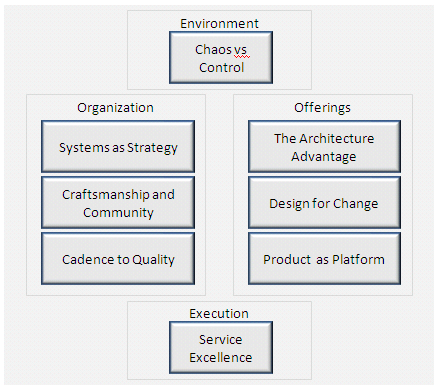Excellence by Design
Excellence by Design (Copyright VPL 2007) was drafted as a set of strategies to enable companies to systemically improve their execution and capability. It was based on my career experiences and was accelerated after the rise of the Internet, e-Business, and the anticipated global technology disruption. While the specific ExD techniques may have changed over time, it was surprisingly predictive of the future, and its basis for leadership and organizational management theories are even more relevant today. in fact, I spend a great deal of my time advising CIOs how to develop more agility, innovation, and efficiency in their organizations... e.g. excellence by design.
Excellence by Design is founded on these beliefs.
The key Themes of Excellence by Design are shown below and described immediately after.
Excellence by Design is founded on these beliefs.
- The world has shifted to be essentially uncontrollable and unpredictable. This is due to the convergence of many factors but the largest are Technology advancement, the rise of Consumerization, and Globalization and its elimination of barriers to entry. As a result, the capability of change to occur has dramatically accelerated: innovation is quicker to arise, faster to market, and more easily adopted by wider audiences. The rise of Digital Business and the new Global Politics has accelerated the pace of change and greater unpredictability of business.
- Business must design flexibility into their organizations, products, and services to thrive in this environment of unpredictability by better understanding the impact it will have on their markets, building the organizational competencies needed for this fast changing world, and crafting products and services that are designed for agility and change. This need for more agility in business has only increased and become more dependent on technology, but in very different ways than the past, with increasing use of cloud, platforms, ecosystems, APIs, IOT, and data...and the near irrelevance of traditional server/storage details or massive ERP/CRM systems.
- Business can succeed by applying key principles of excellence by design to their organizational culture, competencies, and processes as well as to the management and design of the products and services the business creates. The principles were originally crafted from an information technology perspective but are also applicable to non IT challenges of constant and unpredictable change. While the framework below is hardly the only one (there are today many frameworks to consider from many Companies), there is still core value in it and the principles are, remarkably, even more relevant today as Digital Agility becomes more critical.
The key Themes of Excellence by Design are shown below and described immediately after.

